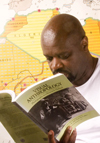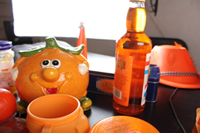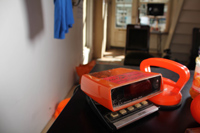


A Future Museum of the Present (Een Toekomstig Museum van het Heden), grew both out of a long standing interest in Archives, their formation and their ability to shape our reception of historical narrative, as well as a new interest in the subversive potential of what could be described ‘tricksterism’ as a working methodology within art practice. In this case, ‘tricksterism’ refers to a body of practices which employ strategies such as parody, inversion, shape-shifting, comedy, profanity, masquerade and encoding as a means of subverting dominant narratives.
The Future Museum attempts to interrogate and problematize the assumptions of authority embodied within the act of forming the Museum or Archival collection. It seeks to do this through a set of strategic acts of parody and ‘masquerade’. As in the traditions of Caribbean Carnival where the act of masquerade was often used to copy, parody and thereby render absurd the actions of the ruling classes, the idea of the ‘trickster’ figure is activated to parody the assumptions inherent in ‘Museum and Archive building’.


Taking a lead from the work of ‘trickster’ artists such as David Hammons and William Pope. L (proclaimed ‘The Friendliest Black Artist in America(1), a set of actions are devised through which the artist assumes the task of ‘making’ a museum.The evident fact of the artists subject position, of being a non Dutch speaking, ‘ethnically’ non European ‘outsider’ (a set of differences which are, within the project, visible but un-referenced) is specifically calculated as a critique of the assumptions contained within historic acts of ethnographic and anthropological museum and archive building. Within these historical acts the (invariably) European archaeologist, anthropologist or ethnologist, would cast his classifying gaze over societies and groups other than his own and attempt to construct a codex of knowledge. The resultant data, although inevitably partial, contingent, subjective and strategically slanted to bolster the imperialist project, would, through the assumed authority of the author become accepted and fixed within the archive/museum as absolute objective evidence.
In the case of A Future Museum of the Present, the impulse on the part of the archive builder to unilaterally declare particular objects, habitats, traditions and activities within the observed culture as ‘archivally significant’ and to employ them in an effort to postulate particular bodies of knowledge, is destabilized through parody. However, unlike the conventional Ethnographic Museum where the ‘subjects’ are distant, disempowered and unvoiced, in the case of the Future Museum, the subjects are ever present collaborators, actively and knowingly drawn into the parodic intentionality of a project where national motifs are reflected back through the distorting perspective of the outsider.
(1)From the essay by Mark H.C.Bessire. ‘William Pope.L, The Friendliest Black Artist in America’. MIT Press. 2002 p22

